One morning, more than twenty years ago when I was still living in a small city in the westernmost end of Java, I was having instant noodles while watching a Japanese anime on TV. My father who had been noticing this new habit I was picking up suddenly asked me a question.
“Why are you eating with chopsticks?” He wondered, because usually I always used fork.
“I want to study in Japan!” my young self confidently replied. At that time I believed the first step to making that dream come true was learning how the Japanese ate.
Many years before this conversation happened, my father – at that time still working in the island of Borneo – and a few of his coworkers got an opportunity to take a short course in Japan due to their satisfying performance at work. But there was one condition: English proficiency was required. My father spoke almost zero English, knowing only how to say yes and no. Having given up the rare opportunity, he then wanted a “revenge”, not through him, but me, by enrolling me in an English course – which was very limited in the small city in western Java where I spent my primary school years.
At the age of 12, my parents and I moved to a bigger city more than 300 km away to the east. My father naturally looked for English course options available in the city and enrolled me in one that was easily accessible from home. You might ask, isn’t English taught at school? People of my age typically had their first English class in junior secondary school. But as the quality of teaching was rather unreliable, my father believed I should take an additional four-hour weekly course off school.
Like most Indonesian kids at that time, I grew up watching anime and reading manga. Both have been serving well as Japan’s agents of soft diplomacy which help improve the country’s profile and popularity among Indonesians. A classmate in high school sent a letter to the Japanese embassy in Jakarta, and in return she got a colorful booklet filled with images of fascinating Japanese cultural scenes. Through that booklet I learned for the first time about the three components in Japanese writing system, as well as other tidbits about the country. In the same year, I was introduced to Detective Conan, and became somewhat a fan of the thriller manga series. The first book I had sported Conan with Tsutenkaku (translated as Osaka Tower in the Indonesian version) on its cover.
People say that childhood is a time filled with dreams and inspirations, and adulthood is when we bring them into reality. Sixteen years after I bought my first Detective Conan comic book, I find myself in a taxi with James on a Friday afternoon. We are stuck in the middle of Jakarta’s notorious traffic to get to the airport and leave for Osaka before midnight. Fortunately the flight departs on time, the Japanese inflight meal is very decent and tasty, and we manage to get enough sleep to prepare ourselves for Osaka the next morning.
As the plane makes its final approach to Kansai International Airport in the middle of Osaka Bay, endless sprawl of urban agglomeration stretches as far as the eyes can see. With a population of almost 20 million people, Osaka’s metropolitan area is in fact Japan’s second largest after Tokyo. And being one of the country’s main gateways, in 1994 a new, bigger airport was inaugurated after seven years of construction. Built on an artificial island which sits on top of clay in an area highly prone to earthquakes and typhoons, the new airport was considered an engineering marvel at that time.
Our train takes us to Shin-Imamiya station, where we get off and find ourselves in the middle of blocks of nondescript multistory concrete buildings. James told me earlier that he had booked a hotel near Tsutenkaku, the tower I’ve been associating Osaka with, so I keep looking for it as we walk down the streets to find where our hotel is. “There it is! I see it!” my excitement is probably comparable to spotting the Eiffel Tower or Big Ben – that exhilaration one feels upon seeing a famous landmark for the first time.
At the hotel, a mid-aged woman and a younger staff member welcome us in a very Japanese way, polite yet efficient. “I was in Bali once!” one of them enthuses after finding out that I’m from Indonesia. The hotel itself is located on one of the arcade-lined streets radiating out from the tower, probably among the most lively areas in the city. At a nearby convenience store, I witness firsthand how Japanese work ethic is practiced by the locals as part of their culture. A woman, who’s probably twice as old as I am, tends the cashier. At the same time, she enthusiastically greets shoppers and makes announcements through a microphone placed a few steps away behind her. She does all that in a speed three to four times as fast a shop assistant a third her age in Jakarta would. Truly impressive!
Our limited time in Osaka means we have to carefully plan out what we want to visit in the city, and as history and architecture buffs Osaka Castle is obviously among the places on top of our list. Japan’s railway system might seem a little daunting for a first-timer, but thanks to James who can read kanji – one of the three components in Japanese writing system – my train experience in the country goes rather smoothly. Train arrival is signified by jolly melodies playing in the station, and a delay – even if it’s just a few minutes – is usually notified in an apologetic announcement.
The skies are cloudy and the air humid as we step out of the nearest train station to the castle. But fortunately as we walk inside the ramparts, past some shops to our right, the sun begins to shine and the clouds slowly clear up. The castle’s architecture dates back to the late 16th century, a period when Japan was ruled by shoguns (military dictators) even though officially the emperors held the highest authority. In 1931, the main keep was restored following years of damage and neglect.
Its facades are embellished with gold-plated ornaments which shine in the midday sun. Toyotomi Hideyoshi, the feudal lord who commenced the construction of the castle, was indeed fascinated with gold. He ordered that furniture, weapons, armors, even the exterior of his castle to be coated with gold to show off his wealth and impress visitors. More than four centuries later, the castle is still as magnificent as it must have been during its heyday.
As the sun shines even brightly, and the day gets hotter, we take a respite at a matcha-themed shop. With a matcha (Japanese green tea) soft ice cream and melt-in-your-mouth matcha mochi in our hands, we conclude our short visit to the castle.
Six kilometers south of the castle is another important heritage site in Osaka which not only is important to the city, but also to Japan. Shitenno-ji is regarded as the country’s oldest Buddhist temple, which has been in operation since the late 6th century. It has been rebuilt over the centuries with much of the current structures a result of a restoration in 1963. Its five-story pagoda is a prominent landmark in the area, surrounded by several gates and belfries.
Back in Shinsekai district of Osaka where Tsutenkaku is located, big octopus-filled balls of takoyaki catch our attention. Made from dashi-flavored batter which is then grilled and served with sweet sauce, bonito flakes and lots of spring onion, it is hands down the best takoyaki I’ve ever had. When night falls, the entire neighborhood turns into a spectacle itself with neon-lit giant signboards and colorful lanterns giving the streets a very festive ambiance. Under the watchful eyes of giant puffer fish and a red octopus, we wander around and decide to try one of several places that serve okonomiyaki, one of Osaka’s delicacies. Unlike in the videos I had watched prior to the trip where a chef prepares the dish in front of customers, then serve it to them, we learn that making okonomiyaki is in fact largely a do-it-yourself activity. A staff member notices our confusion and shows us how to cook the dish. Despite his lack of experience preparing okonomiyaki himself, the thick savory pancake filled with meat or seafood, carrot and shredded cabbage, drizzled with thick dark sauce and mayonnaise that James makes turns out to be really delicious.
In Detective Conan, Shinichi Kudo – the protagonist who’s from Tokyo – often mocks his fellow detective from Osaka, Heiji Hattori, for his Kansai accent which sounds rough and rude to the people from the capital. This stereotype stems from 18th-century Edo (present-day Tokyo) literature, corroborated by its residents, which depicted Osakans as stingy, greedy, lewd and gluttonous people who spoke in a vulgar way. If gluttony is something Tokyoites still associate with Osakans today, I surely have fallen into it, thanks to those delectable and succulent takoyaki and okonomiyaki.



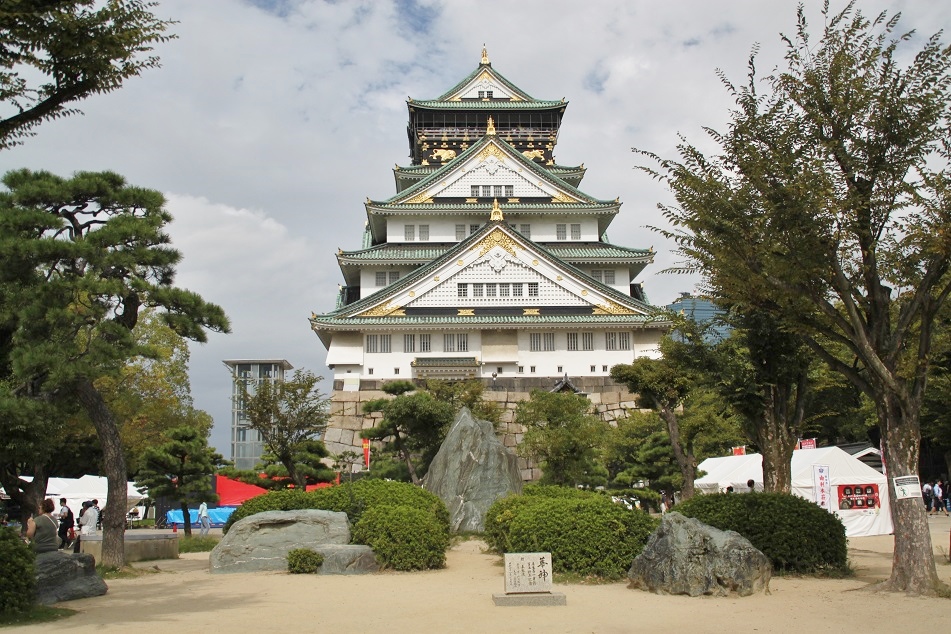
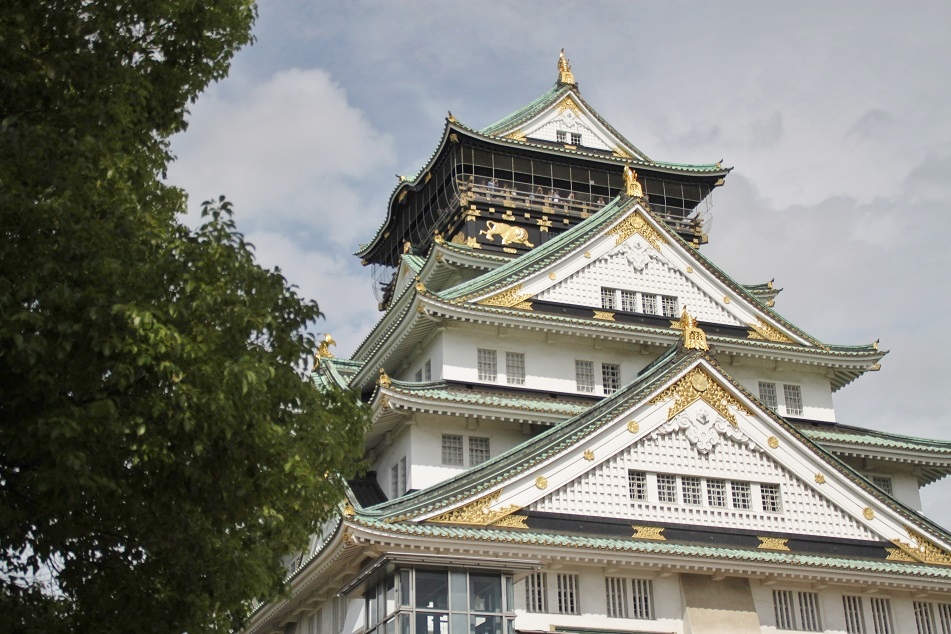



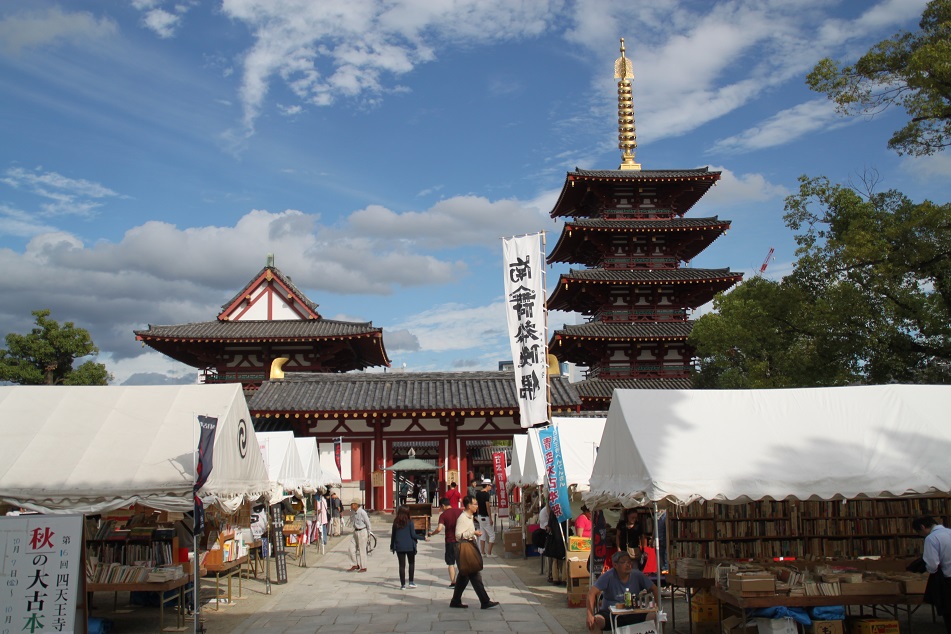
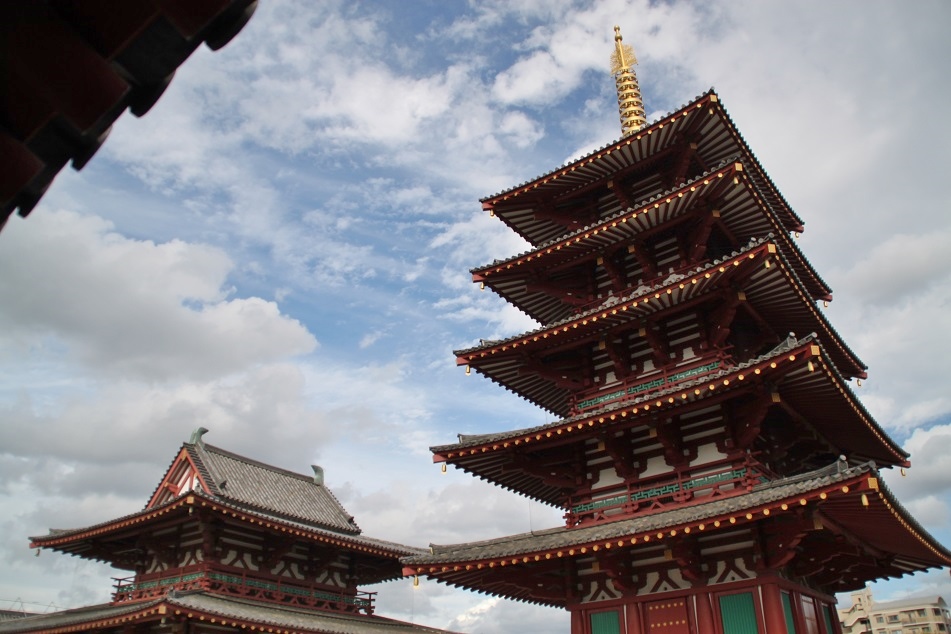
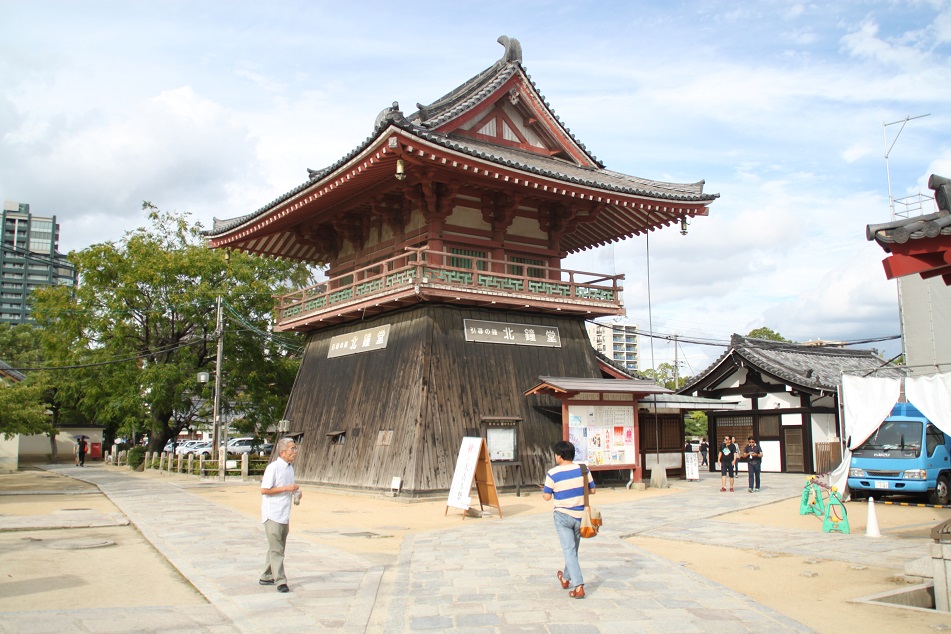
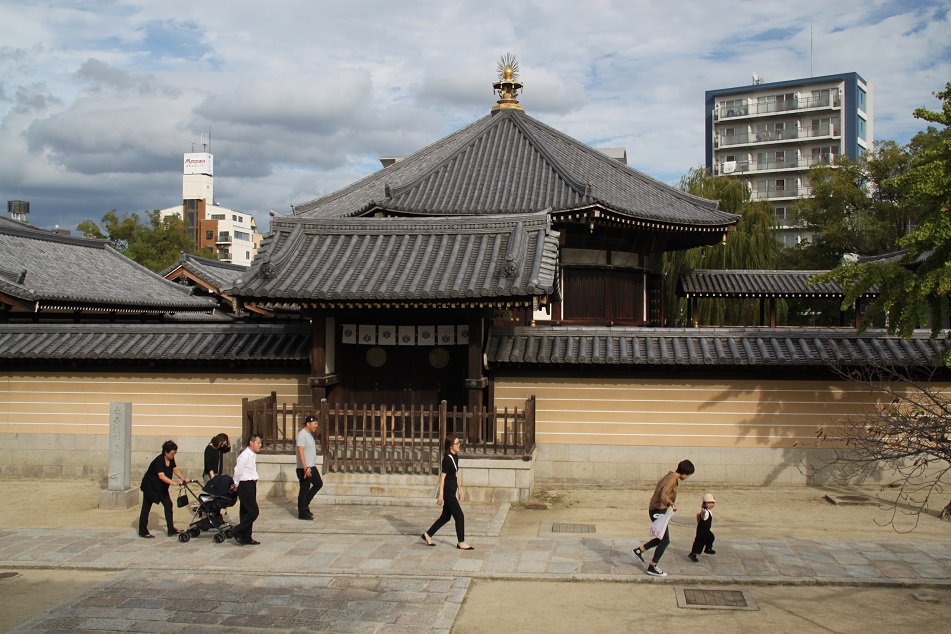
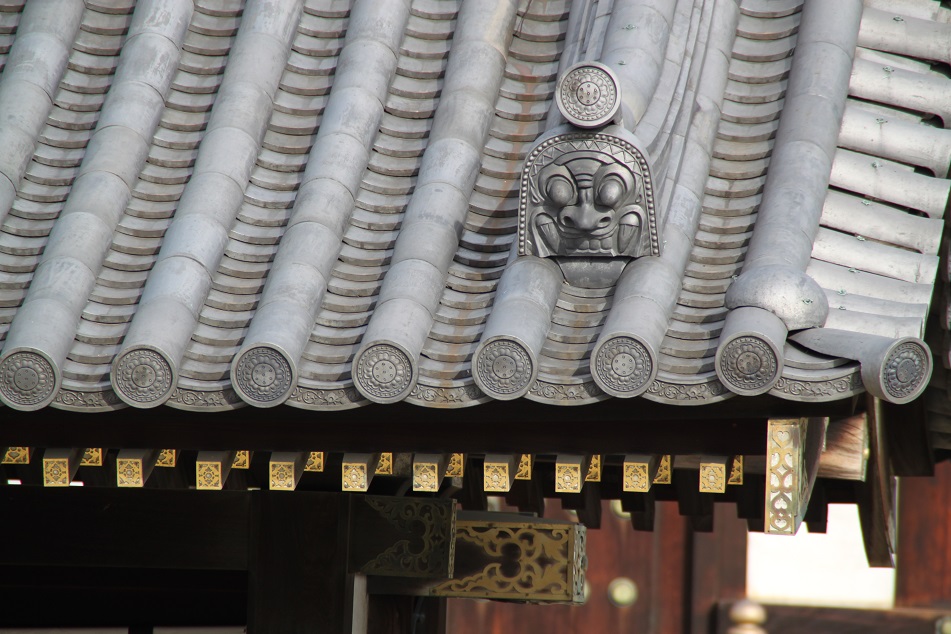

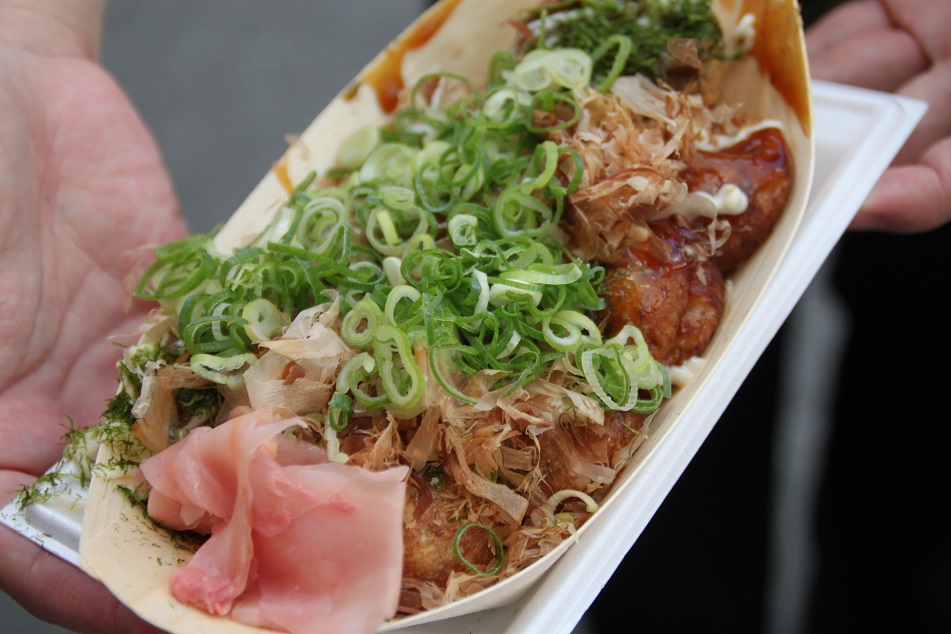



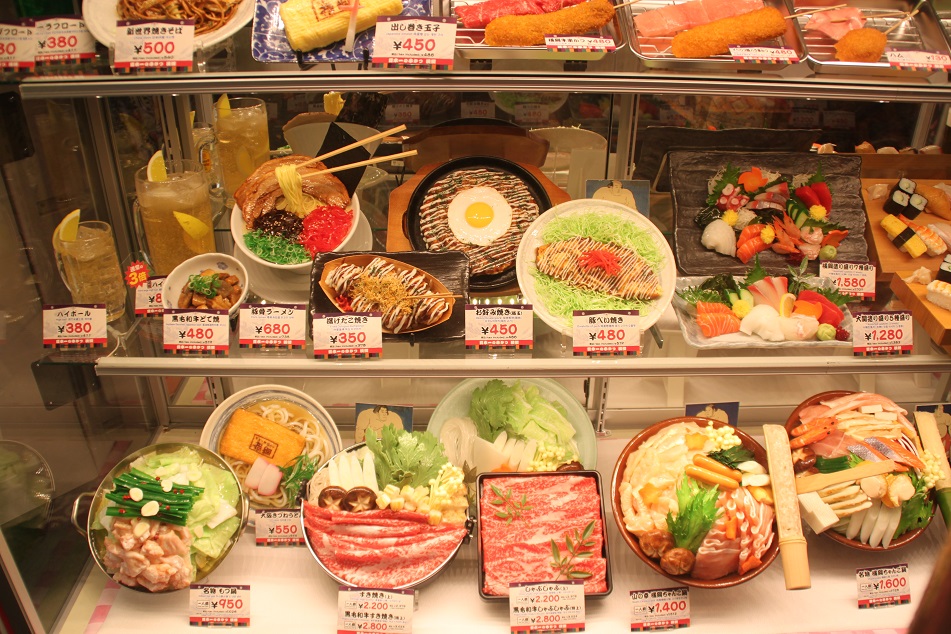

Jepang, negeri impian hampir semua orang, termasuk aku (karena sejak kecil sudah terbiasa dengan hal2 berbau jepang, hingga kini pun)
LikeLike
Manga, anime, dan aspek-aspek kultural lainnya memang menjadi bagian dari diplomasi halus yang dilakukan Jepang sebagai bagian dari strateginya untuk meningkatkan image-nya di masyarakat internasional. Hebat sih kalau dipikir-pikir ya, bisa kepikiran sampe ke situ.
LikeLiked by 1 person
hooh…apalagi kalau nonton Begin Japanologynya NHK, beuhh…saat ekonomi jepang lagi bagus2nya di awal 60-an, jadi mikir, mereka dulu sudah berpikiran sejauh itu, tak salah sekarang mereka menjadi negara maju, walaupun kenyataan jepang juga menghadapi tantangan penyusutan penduduknya ke depan karena tingkat kelahiran yang sedikit dan banyakan lansianya. Di pref.apa namanya juga saking sepinya, penduduk bikin boneka yang dipajang di pinggir jalan hingga bekas sek0lah, ironi juga : )
LikeLike
Wah saya baru denger ada boneka itu. Penyusutan jumlah penduduk memang jadi tantangan besar untuk Jepang sih, di sisi lain di Indonesia terlalu banyak penduduk jadi tantangan. 🙂 Oiya, NHK itu menurut saya salah satu channel TV yang sukses memperkenalkan nilai-nilai dan budaya negaranya ke seluruh dunia. DW punya Jerman juga cukup sukses dalam hal ini. Sementara itu channel TV milik beberapa negara agak terasa muatan propagandanya, ada juga yang biasa-biasa aja jadinya kurang berkesan.
LikeLike
salah satunya RT nya Rusia heheheh atau sudah wajib yang KCNA nya korut : )
LikeLike
Hehe iye bener, RT sih terang-terangan banget. Kalau KCNA sih ya sudah lah ya. Kalau mereka gak nurut sama pemerintahnya taruhannya nyawa.
LikeLiked by 1 person
RT itu kayak isi beritanya tentang kritikan ke US dan Eropa Barat kadang bikin gimana gitu, tapi ya sekali lagi, banyak memang media yang dijadikan propaganda oleh pemiliknya tentunya untuk kepentingan masing-masing : )
LikeLike
Sampe-sampe ada anchornya resign pas lagi siaran langsung warta berita. Mengetahui siapa di balik sebuah perusahaan media memang penting untuk memahami arah dari media tersebut. Ada yang cukup bisa independen dari kepentingan pemilik modal, ada yang terang-terangan disetir. Sebagai konsumen kita harus cerdas merangkai narasi yang ada untuk memahami secara utuh dan dari sudut pandang beragam mengenai suatu berita.
LikeLiked by 1 person
Thank you so much for sharing this!
I’m heading to Japan in a couple days, and can’t wait to try everything!!!
LikeLike
My pleasure, Ryan, and thanks for reading. How many days will you spend in Japan? Wish you have a great time there!
LikeLiked by 1 person
I’m there for 2 weeks! Can’t wait!
LikeLike
Baaammm.. Gw mo ke jepang nanti. Lu kemana lg selain Osaka?
LikeLike
Lo bukannya udah pernah ke Jepang ya Jo? Gw waktu itu ke Osaka, Okayama, Kurashiki, Himeji, Kyoto, sama Nara.
LikeLike
Fascinating Bama. Aren’t you glad your father made you learn English?! One day we’ll get to Japan. I’ve been reading a couple of blogs about it lately and it seems to me to be a very ancient unique culture hidden by a deceptive veneer of modernity. I love your night shots.
Alison
LikeLike
Back then, I felt that I was different from other kids. I had to attend the course twice a week in the afternoon while most of my friends were out playing. Education is the best investment my parents have provided me. I think you would enjoy Japan, Alison. On the surface yes there are these monotonous buildings — many were built following the destruction during World War II. But when you go deeper, the Japanese are similar to the Balinese. They embrace modernity while still holding on to their culture and traditions. Thanks Alison!
LikeLiked by 1 person
If Osaka’s food always looks this good, I don’t might to be a gluttonous Osakans as well 🙂 I think not just Indonesian but the whole Pacific Asia is influenced by anime and manga. Most people at our age have read at least one issue of Conan, Dragon Ball or Doraemon (my favourite one). And don’t forget the video games. Nintendo and Play Station shape our lives 😉
P.S: It is noon and I wish I could have a piece of that takoyaki!
LikeLike
I know, right? Tokyo was clever to include some of Japan’s most iconic characters during its presentation at Rio 2016 closing ceremony. That makes me wonder if we will see Goku, Naruto, Sailormoon, Pikachu, and other characters at Tokyo 2020 opening ceremony.
Takoyaki is relatively easy to find here in Indonesia, although none is as good as the ones I had in Osaka. You live in Hamburg, right? Is it hard to find Japanese restaurants or food stalls there?
LikeLiked by 1 person
Yes, it is difficult 🙂 As far as I know, there only two authentic Japanese restaurants and one ramen bar in Hamburg. Food stalls are only available during the Cherry Blossom Festival. But even there, the choice is very limited and the food looks rather dull. But if you only look for sushi, you can find it almost everywhere. Most Asian bistros and some fusion restaurants do have sushi.
LikeLike
Sushi is indeed everywhere. At an old shopping center next to my office, there are several small sushi restaurants tucked in the middle of garment, glasses, medicine, watch, and shoe shops. 🙂
LikeLike
Osaka was an ideal starting point for our trip to Japan – I’m glad it was the fruition of a childhood dream for you! I have never had better takoyaki and the matcha soft serve ice cream was heavenly. It makes me wonder what we might have eaten (and seen) had we stayed another night in the city. Bama, I have to add that those after-school English lessons and your love of reading English-language magazines really paid off. 😉
LikeLiked by 1 person
At first I was a bit worried whether we had enough time to explore Osaka or not. But thanks to your research, we managed to squeeze in all the most important places in the city. There used to be a place which served decent matcha ice cream at my old office, but they had stopped selling it. So to have the real one in Japan was really special.
Well, there are some wonderfully-written English-language blogs, including yours, which help me improve my writing. 🙂
LikeLiked by 1 person
Fascinating to read about the origin of your English classes Bama. Our parents yearn for us to have more than they did. Japan has not been high on our radar however after reading your post and others recently my wanderlust is sparking. Thank you for a beautiful tour and sharing the story of your childhood.
LikeLike
I’m glad they put education as the highest priority for their son. Japanese cities might look the same — urban sprawls with incongruous concrete buildings. But their castles, temples, palaces and natural landscape are definitely among the best and most unique things about the country. Oh, and their fascination of kawaii-ness, ‘cuteness’, makes their TV programs, buses, trains, trams, pretty much everything look more interesting. Thanks for reading, Sue.
LikeLiked by 1 person
Another bucket list place!! Thank you!
LikeLike
My pleasure, John. Wish you can come to Osaka sooner than later.
LikeLike
I truly can relate the fascination of manga during junior and high school period, as my friends were also “infected” with this trend. I haven’t read Detective Conan, though, but I was (and still) a huge fan of Doraemon and remembered watching the series on TV every morning at 8 am. The trend lasted for several years, long enough to build a dream of going to Japan, visiting the places where your favourite characters usually hang out and live their life.
I’ve been to Japan before, making my dreams come true by visiting Fujiko F. Fujio Museum or Doraemon Museum. But never been to Osaka and that’s where I will be within 6 months from now. So excited to read your post, an interesting story, and I just knew there’s a DIY station for creating your own okonomiyaki. That would be exciting! Thanks for sharing.
LikeLike
I rarely watched the Doraemon anime series, but I was a big fan of the ‘Doraemon Petualangan’ manga. Now that I think of it, my childhood was indeed filled with everything Japanese, from Satria Baja Hitam to Dash Yonkuro, Saint Seiya, Dragon Ball, and many more. I don’t know how kids programs on Indonesian TV look like now, though.
Visiting Fujiko F. Fujio Museum must have been a very exciting experience for you, I can imagine. I think the video of that okonomiyaki restaurant I watched was shot in Dotonbori area. While the one I tried was in Shinsekai. Have a great time in Osaka later this year! And thank you for reading and sharing your thoughts.
LikeLike
What a fascinating trip! You truly have seen so much! I have so much I hope to see in Asia! Someday I will get over there and I’m sure I’ll need months and months.
LikeLike
And I have so much I hope to see in the Americas! I think Japan has some scenic hiking trails which you might love, Nicole. And of course all those Buddhist and Shinto temples and shrines, ancient castles and palaces, and beautiful gardens. Maybe one day you can bring your kids and husband along to explore Japan.
LikeLiked by 1 person
I would love to Bama! So many places I want to see in the world!
LikeLike
The list just keeps growing, doesn’t it?
LikeLiked by 1 person
I see you have not left food behind at the end of your Spice Odyssey series! 🙂 I also loved your segue from childhood anime and manga pastimes to this trip. Japan has been slowing making its way up my travel wish list, and Osaka will definitely be on the itinerary along with a few other major cities and a nice hike along the Nakasendo!
LikeLike
You noticed. 🙂 I guess my travels will always involve trying some local dishes. I had to look up Nakasendo, and apparently it’s one of the Edo-period routes that connect Tokyo and Kyoto. How fascinating! I haven’t heard anyone who’s disappointed with Japan, so I do hope you’ll get there soon enough since there are direct flights from Houston to Tokyo. Thanks for reading, Lex!
LikeLiked by 1 person
All your followers above expressed their admiration for your informative post on your Japan experience with its amazing pictures. So let me marvel at your English skills showcasing your amazing way with words and your impeccable grammar. Super job, my friend!
LikeLike
I was so enthralled by everything I saw in Japan, which probably helped set the tone of this post. Peter, as always, you’re so kind. Thanks! As for the grammar, I still do mistakes every now and then. 🙂
LikeLiked by 1 person
Loved reading it! Have never made it to Japan, would love to for so many reasons…
LikeLike
For some reason this comment ended up in my spam folder! Luckily I checked all the spam messages first before deleting them. I would say Japan has everything for everyone. People I know who love shopping loved Japan. So did those who are more interested in its history and culture. For nature lovers, Japan surely has many beautiful places to choose from. Thanks for reading, Julz!
LikeLiked by 1 person
I wonder why all my comments end up in Spam 😥
LikeLike
Only this one though. Don’t worry, it happens sometimes.
LikeLike
Only once here, but many places my comments seem to end up in the spam… but hey glad you checked 🙂
LikeLike
I am THAT much more excited about visiting Osaka in January now!!! Your photos look amazing – especially that matcha ice cream and mochi!!
LikeLike
Glad this post got you even more excited for your upcoming trip. I wonder if the matcha ice cream will be available in January since it’s winter. But even if it’s not, I’m not sure there will be other intriguing dishes to try, being Japan! Thanks Jess.
LikeLiked by 1 person
I absolutely love reading about your expereince in Japan – a dream come true for a young boy turned man!
p.s. Great photography too! 😀
LikeLike
Thanks Victoria! As adults, we should still have dreams because one day they may come true.
LikeLiked by 1 person
Your excellent posts always make your readers want to run out and buy a ticket to that destination! The contrast of modern vs building styles of the past is striking – the graceful roof lines and ornamentation on the temples and castle is exquisite! Thanks for sharing a bit of your life story!
I am sending this to a friend who loves Japan and will enjoy your writing and photos.
LikeLike
That’s very kind of you, Marilyn. The Japanese seem to know how to keep everything delicately balanced. No temple or castle is too richly decorated, but none is too austere either. This also applies to their food and traditional costumes, among other things.
Thanks for sharing this post to your friend!
LikeLike
I agree with Marilyn: your post makes me want to visit Osaka (and enjoy Okonomiyaki haha). You know that I studied Japanese and lived near Kyoto for a couple of months. But all that happened back in 1996. My last visit to Japan was in the year 2000. I’m desperately looking to find the best time to return. I’d love to return to enjoy the politeness, the great food and stunning architecture. Osaka doesn’t have as much historic places as Kyoto has, but the urban landscape is on it’s own worth a visit (the area of Dotonbori was inspiration for one of my favorite movies ever: Blade Runner). Thanks for showing these lovely sights of Japan!
LikeLike
17 years is a long time, Emiel. I guess it’s about time you return to Japan and experience again all the goodness the country has to offer. Prior to my trip, I always heard good things about Japan, its people and the landscape. Now, I’m one of those people who keep telling others how impressive things were in the country. Japan is a place I can see myself returning more than once. I haven’t watched Blade Runner, but judging from the images I found on the internet I can see how Dotonbori inspired the movie. Thanks for reading and I hope you’ll come back to Japan sooner than later!
LikeLike
OMG that Takoyaki and Okonomiyaki though~
Detective Conan and all those Sunday morning’s cartoon on television were also the main reason that encouraged me to visit Japan. And I always want to go back!
LikeLike
Best takoyaki ever! As for the okonomiyaki, it was also nice but I haven’t tried other places, so I can’t compare.
Ah those Sunday morning anime series! Sometimes I still watch some on YouTube. 🙂 Then go back, Mira. I’m also telling myself the same thing.
LikeLike
I love the way you’re so passionate about every little aspect that you say in your blog. It makes it so much more easeful to read.
LikeLike
Tere, Stella! If you saw me in person when I was in Japan, probably I looked like a kid in a toyland, or candyland, you know … such places. I was so excited and fascinated by everything I saw, tasted, and felt. I guess that shows in this post. 🙂 Thanks for reading!
LikeLiked by 1 person
We like to joke we went to Osaka just for the food… some AMAZING eats there! Your photos just make me want to go back…
This was our experience, if you’re curious 🙂 https://lotsasmilesphoto.com/2016/01/08/japan-day-11-kiyomizu-osaka/
LikeLike
That’s true. Everything I had in Osaka was delicious — in fact almost everything I ate in Japan really didn’t disappoint. Love your post. It really brings back some good memories from my trip to the country last year.
LikeLiked by 1 person
Thank you! Yeah, we didn’t really have any bad food in Japan. I miss that food….
LikeLike
Osaka seems like an amazing place which I hope to visit soon. Excellent post, Bama!
LikeLike
Thanks Agnes. I didn’t know you have another blog focusing on keeping fit while traveling. Well done! When you do come to Osaka, I guess you won’t find it hard to stay fit despite all the good food.
LikeLike
Thanks for that lovely wander through Osaka Bama. My visit with my sister on that 2012 escorted trip was restricted to the castle. We were both due to return this April – she was attending an Ikebana conference in Osaka, and I was tagging along as I usually do with whoever invites me to come along – but things began unravelling before we could make our final bookings. Certainly hoping to return to Kyoto and Tokyo, if not Osaka.
LikeLike
Glad you enjoyed this, Madhu. Just last night James and I were discussing about a plan I made to visit Tana Toraja in Sulawesi back in 2012. I had booked the flight tickets, but in the end due to the circumstances I decided to cancel the trip. I finally went during the big trip almost two years ago, and the wait really paid off. I only stayed one night in Osaka, but certainly you can spend more time in the city since it has quite a lot to offer. I hope you don’t have to wait that long to return to Japan, Madhu!
LikeLike
Wow this looks incredible! That takoyaki looks unbelievable!
LikeLike
That does takoyaki taste as good as it looks. Thanks for dropping by, Sherif!
LikeLiked by 1 person
Well-written article coupled with beautiful pictures! ❤
LikeLike
Appreciate your kind words, Franz! Thanks for dropping by.
LikeLiked by 1 person
This is a great narrative! The pictures are also nicely done! I’m craving for some takoyaki now and okonomiyaki!
LikeLike
Thanks for your kind words! Hope you didn’t get too hungry after looking at the photos of takoyaki and okonomiyaki. 🙂
LikeLiked by 1 person
I am planning for Osaka trip and your blog gives me ideas of where to go and what to do. Great post!
LikeLike
Glad this blog helps you plan your trip to Osaka, Vera! Thanks for reading!
LikeLiked by 1 person
Pingback: Nijo-jo: From the Hollyhock to the Chrysanthemum | What an Amazing World!
Pingback: Destruction and Rebirth of Gyeongbokgung | What an Amazing World!
Pingback: Jordan and A Travel Resolution Fulfilled | What an Amazing World!